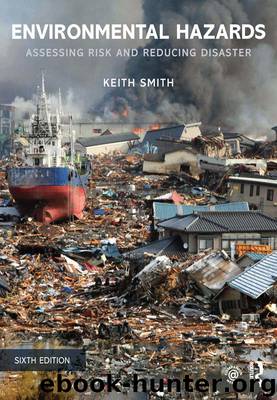Environmental Hazards by Smith Keith

Author:Smith, Keith
Language: eng
Format: epub
ISBN: 9781136647147
Publisher: Taylor and Francis
Published: 2013-01-16T05:00:00+00:00
Figure 9.9 The generalized tracks of seven severe wind-storms crossing western Europe in the 1999–2010 period. Unlike hurricanes, mid-latitude cyclones can create damage well inland of coastal areas. After Kafali (2011). Reproduced from C. Kafali, Regional Wind Vulnerability in Europe. Report 04.2011, AIR Currents, AIR Worldwide. With permission from AIR Worldwide.
Figure 9.9 illustrates the tracks of seven major ETCs that crossed Western Europe in recent years, including the path for storm ‘Kyrill’, which continued to Poland and the Baltic states (Kafali, 2011).
In areas exposed to the frequent passage of winter depressions the on-going loss is high. For Britain, Buller (1986) claimed that an average of 200,000 buildings, mainly domestic properties, were damaged by wind-storms each year. In October 1987 a small depression deepened very rapidly in the Bay of Biscay and then moved over Western Europe. Heavy losses were sustained in southern England, but the storm came at night and there were only 19 direct fatalities. Casualties in other countries raised the total death toll to about 50. Forestry suffered badly; in England alone more than 15 million trees were lost. Much infrastructure damage was due to trees falling onto power lines, houses, roads and railways. In Central Europe there is evidence of a long-term increase in forestry losses due to ETCs that may be associated with a rise in winter temperatures, because most damage to woodland occurs with wind-throw when soils are unfrozen and very wet (Usbeck et al., 2010).
Severe Atlantic storms appear in clusters. Between January and March 1990 four severe storms (‘Daria’, ‘Herta’, ‘Vivian’ and ‘Wiebke’) caused more damage than any previous natural disaster over Western Europe (Figure 9.10a). In these storms 230 people died and the insurance loss was more than €8 billion (Munich Re, 2002b). The storms produced high gust speeds over a wide area, mostly during daylight. Although the storms were forecast, adequate warnings advising people to seek shelter were not issued. People continued their outdoor activities, and most deaths were due to trees falling onto road vehicles. In Britain alone, an estimated 3.5 million trees were lost in this event.
In December 1999 three separate storms — ‘Anatol’, 2–4 December; ‘Lothar’, 24–27 December; ‘Martin’, 25–28 December — set new
Figure 9.10 Insured losses suffered in four named European windstorms in 1990 (‘Daria’, ‘Herta’, ‘Vivian’ and ‘Wiebke’) compared to the losses in three similar events in 1999 (‘Anatol’, ‘Lothar’ and ‘Martin’): (a) the losses created by individual storms; (b) the aggregate losses in individual countries. Compiled from data in Munich Re (2002b).
Download
This site does not store any files on its server. We only index and link to content provided by other sites. Please contact the content providers to delete copyright contents if any and email us, we'll remove relevant links or contents immediately.
| Anthropology | Archaeology |
| Philosophy | Politics & Government |
| Social Sciences | Sociology |
| Women's Studies |
Cecilia; Or, Memoirs of an Heiress — Volume 1 by Fanny Burney(32499)
Cecilia; Or, Memoirs of an Heiress — Volume 2 by Fanny Burney(31911)
Cecilia; Or, Memoirs of an Heiress — Volume 3 by Fanny Burney(31895)
The Great Music City by Andrea Baker(31759)
We're Going to Need More Wine by Gabrielle Union(19004)
All the Missing Girls by Megan Miranda(15781)
Pimp by Iceberg Slim(14437)
Bombshells: Glamour Girls of a Lifetime by Sullivan Steve(14024)
For the Love of Europe by Rick Steves(13620)
Talking to Strangers by Malcolm Gladwell(13293)
Norse Mythology by Gaiman Neil(13281)
Fifty Shades Freed by E L James(13188)
Mindhunter: Inside the FBI's Elite Serial Crime Unit by John E. Douglas & Mark Olshaker(9265)
Crazy Rich Asians by Kevin Kwan(9224)
The Lost Art of Listening by Michael P. Nichols(7455)
Enlightenment Now: The Case for Reason, Science, Humanism, and Progress by Steven Pinker(7274)
The Four Agreements by Don Miguel Ruiz(6703)
Bad Blood by John Carreyrou(6584)
Weapons of Math Destruction by Cathy O'Neil(6220)
